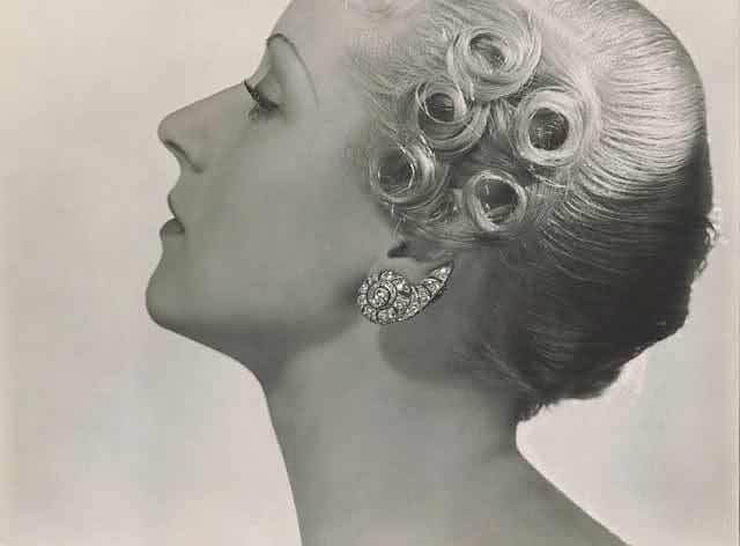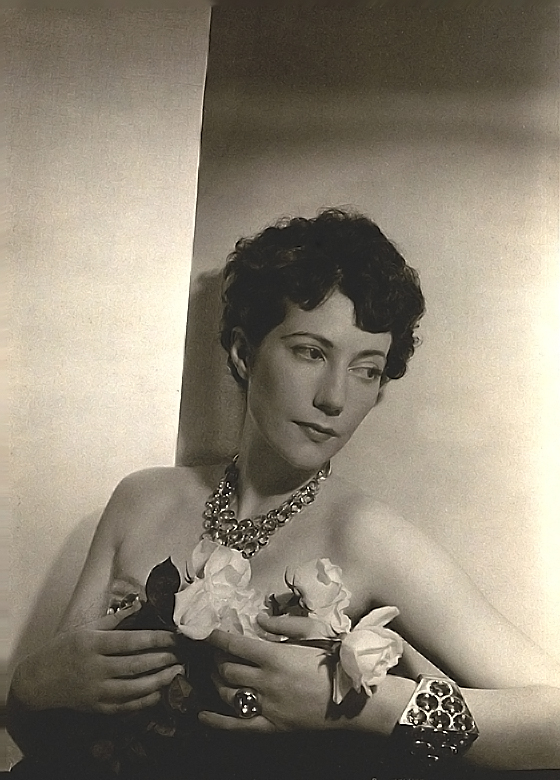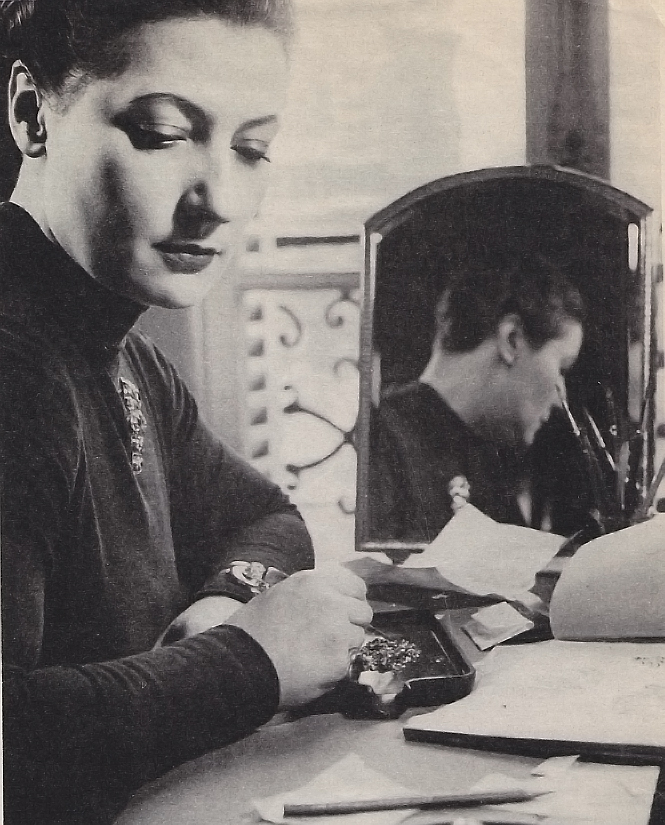René Boivin. Jeweler’s Masterpieces for the Elite
Jewelry House René Boivin fittingly occupies one of the pages of the history of jewelry. Impeccable quality of jewelry made Boivin René House, one of those who defined the style until the mid-twentieth century, very famous.
Jewelry by House of René Boivin was initially created on individual sketches for specific customers, connoisseurs of the beautiful things and was famous for being “alive” — the pieces were turning, twisting, harboring those or other elements in order to suddenly reveal them to the public.

René Boivin. Diamond earrings.
Hereditary jeweler Jules René Boivin founded the René Boivin Jewelry House. René was born in 1864, and from his young age he showed interest in the jewelry art. René’s father was engaged in his training. Young artisan shows incredible talent in etching and jewelry design.
Being ambitious enough, in 1890 at the age of 26 years, René Boivin opens several workshops on the Rue de St Anastase in Paris, thus creating the René Boivin Jewelry House. In 1893, he married Jeanne Poiret and moved to a new Studio on Rue De Turbigo. Jeanne Poiret was the elder sister of Paul Poiret, one of the famous fashion designers of France.

Paul Poiret.
It is due to the influence of Paul, the René Boivin Jewelry House, in which a married couple worked side by side, easily entered the world of high fashion of Paris. At this time, refined and elegant jewels in the shape of starfishes, plants and flowers are their hallmarks. Natural motifs of flora and fauna, embodied in the precious metals and stones, fascinate with their bizarre forms and techniques. Unsurpassed beauty, original style and high quality of the work quickly gain more and more fans. To 1905, René’s works became demanded so much that he no longer had to make pieces for other jewelry houses; there were more than enough orders from wealthy clients.

Millicent Rogers. Starfish-shaped brooch by René Boivin.
René was known for his love of flowers. It is floral motifs to have glorified the House of René Boivin in the early twentieth century. The goldsmith subscribed for numerous botanic publications. The orchid was his favorite flower. Flowers, made by René Boivin, of course, were one of the best examples of the jeweler’s art of the 20th century.

The Orchid Brooch. René Boivin. Sotheby’s New York.
The works by René Boivin were complex and adventurous at the same time and fully contradicted popular style of Art Nouveau. Some of his works, consisting of realistic and mythological miniature animals, were executed in the style of Art Deco, well before its actual appearance. This style was called the “barbaric” one, and many of these works have never been sold and were dismantled to use their parts in other projects.
True popularity and glory comes to the René Boivin Maison after the death of its founder René Boivin in 1917. Thanks to Jeanne Boivin abstract and quite cold pieces, made by her husband, became known all over the world.

Jeanne Boivin (1871-1959)
If you look at the history of the House of René Boivin, the main surprise is that the House has been ruled by women for many years, the women, who, however, concealed that fact so well that no one knew about it. For forty years, together with her daughter and talented designers, Jeanne Boivin worked in the name and for the benefit of the René Boivin Jewelry House.
Designer, Suzanne Belperron, who was a creeator in the Maison in the 1920-1930s, was far ahead of tastes and possibilities of her time. Saucy and sophisticated jewelry design, soaked with avant-garde trends of Cubism and Art Deco has become a hallmark of the René Boivin Jewelry House.

Madame Max Ernst (Marie-Berthe Aurenche). Necklace, bracelet and a ring
by Suzanne Belperron. Gold, topazes. Vogue France, 1935.
It is Suzanne to develop the René Boivin style, which was made famous in the future, and continued to work for Boivin for ten years until 1932. At once, everyone grew fond of her for her talent, strong and cheerful nature, new ideas and wonderful taste.

Suzanne Belperron.
By this time, daughter Germaine, who became educated in arts, grew up in Boivin family.
In 1932, Juliet Mutard becomes Chief Designer. Jeanne and Juliet help Germaine Boivin to learn the secrets of family craft. The Rene Boivin Jewelry House moved for the last time, on the Avenue de l’Opéra in Paris.

Madame Boivin in the Office on Avenue de l’Opéra in Paris
In 1958, the year after the death of her mother, Germaine takes control of the House in her hands. Fruitful cooperation of Juliet Mutard with René Boivin Jewelry House will last until her death in 1970. Innovative projects by Germaine Boivin are having a great success in many international exhibitions, including the 1937 World’s Fair in Paris, and an exhibition at the French Institute of Decorative Arts in 1947. Despite a generational change, the House of René Boivin remains one of the most innovative in its projects, and the quality of the jewelry masterpieces is impeccable, thus preserving their exclusivity and reputation.

Necklace pendant René Boivin, 1939. Sotheby’s London.
During the 20th century, the House of René Boivin was passed from hand to hand for several times. In 1976, Boivin sisters sold it to Jacques Bernard, the designer, who had worked in the company since 1964. Under Bernard’s management, the René Boivin Jewelry House remains in Paris, like a hundred years ago, until 1991, and successfully opens a boutique under the same brand in London.

Double Clip-Brooch, René Boivin, France, 1940-s. Sotheby’s New York.
In April 1991, the House of René Boivin was purchased by the Asprey Group. Despite the change of ownership, the House of René Boivin continued to produce excellent jewelry, again going back to some of the earlier drafts and keeping the same range, which for many years was supported by Bernard. After Prince Jaffee, brother of the Sultan of Brunei, had bought Asprey, the company was restructured. The René Boivin Jewelry House was closed forever after that.

Fragment of the brooch. René Boivin. Sotheby’s New York.
Over the centuries-old history of the René Boivin Maison, artists, scientists, prominent public figures, such as Sigmund Freud, Edgar Degas, Louise de Villemorin, as well as Hollywood stars and royalty were their customers. For this reason, René Boivin always fancied itself the “jeweler of the intelligentsia”.
In recent years, the name of the French Jewelry House of René Boivin began to appear at major jewelry auctions, consistently attracting the attention of collectors and connoisseurs. Lovely gizmos of the beginning and the middle of the last century, floral motifs, perfect execution –this is what makes detain look at the jewelry masterpieces by René Boivin. Most of them were made to order, in a single copy.

The book dedicated to René Boivin.
Women, who happen to be the owners of creations by René Boivin, rarely part with them. So it can be quite rare to see these things on modern auctions. Each time the emergence of such thing is event. The pinnacle of the jeweler’s art is considered chameleon, made by artisans of René Boivin. Like its natural prototype, it can change the colouring (when you click on the tongue of this miniature animal, the roller, built into its back and studded with emeralds and rubies, is turning). René Boivin has still been a source of inspiration for the world’s jewelry.

Bracelet brooch “Chameleon”. René Boivin.
Cufflinks made by the artisans of the Lobortas House, can be considered as masterpieces of the jeweler’s art, which through a combination of all kinds of aesthetic concepts and images, use of the materials and design solutions, which had not been used in jewelry before, possess great artistic value and remain valid beyond time. The unusual design and unexpected combinations of materials certainly suborn even the most demanding connoisseur of originality.
Jewelry Set «Ambassador», Lobortas House
Photo by Vladislav Filin.










